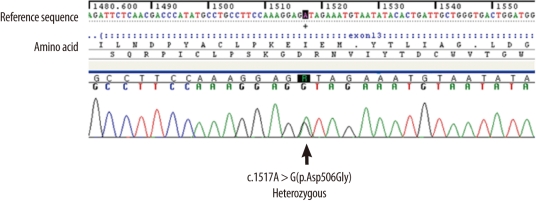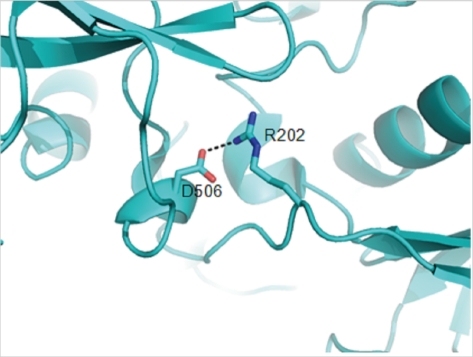Korean J Lab Med.
2011 Oct;31(4):290-293. 10.3343/kjlm.2011.31.4.290.
A Novel Missense Mutation Asp506Gly in Exon 13 of the F11 Gene in an Asymptomatic Korean Woman with Mild Factor XI Deficiency
- Affiliations
-
- 1Department of Laboratory Medicine, Yeungnam University College of Medicine, Daegu, Korea. chscp@med.yu.ac.kr
- 2Department of Internal Medicine, Yeungnam University College of Medicine, Daegu, Korea.
- 3Department of Biochemistry & Molecular Biology, Yeungnam University College of Medicine, Daegu, Korea.
- 4Department of Laboratory Medicine & Genetics, Samsung Medical Center, Sungkyunkwan University College of Medicine, Seoul, Korea.
- KMID: 1781695
- DOI: http://doi.org/10.3343/kjlm.2011.31.4.290
Abstract
- Factor XI (FXI) deficiency is a rare autosomal recessive coagulation disorder most commonly found in Ashkenazi and Iraqi Jews, but it is also found in other ethnic groups. It is a trauma or surgery-related bleeding disorder, but spontaneous bleeding is rarely seen. The clinical manifestation of bleeding in FXI deficiency cases is variable and seems to poorly correlate with plasma FXI levels. The molecular pathology of FXI deficiency is mutation in the F11 gene on the chromosome band 4q35. We report a novel mutation of the F11 gene in an 18-year-old asymptomatic Korean woman with mild FXI deficiency. Pre-operative laboratory screen tests for lipoma on her back revealed slightly prolonged activated partial thromboplastin time (45.2 sec; reference range, 23.2-39.4 sec). Her FXI activity (35%) was slightly lower than the normal FXI activity (reference range, 50-150%). Direct sequence analysis of the F11 gene revealed a heterozygous A to G substitution in nucleotide 1517 (c.1517A>G) of exon 13, resulting in the substitution of aspartic acid with glycine in codon 506 (p.Asp506Gly). To the best of our knowledge, the Asp506Gly is a novel missense mutation, and this is the first genetically confirmed case of mild FXI deficiency in Korea.
Keyword
MeSH Terms
Figure
Cited by 1 articles
-
Cys482Trp Missense Mutation in the Coagulation Factor XI Gene (
F11 ) in a Korean Patient with Factor XI Deficiency
Seung Jun Choi, Juwon Kim, Kyung-A Lee, Jong Rak Choi, Jongha Yoo
Ann Lab Med. 2014;34(4):332-335. doi: 10.3343/alm.2014.34.4.332.
Reference
-
1. Davie EW, Fujikawa K, Kisiel W. The coagulation cascade: initiation, maintenance, and regulation. Biochemistry. 1991; 30:10363–10370. PMID: 1931959.
Article2. Gailani D, Broze GJ Jr. Factor XI activation in a revised model of blood coagulation. Science. 1991; 253:909–912. PMID: 1652157.
Article3. Thompson RE, Mandle R Jr, Kaplan AP. Association of factor XI and high molecular weight kininogen in human plasma. J Clin Invest. 1977; 60:1376–1380. PMID: 915004.
Article4. Berber E. Molecular characterization of FXI deficiency. Clin Appl Thromb Hemost. 2011; 17:27–32. PMID: 20308231.
Article5. Asakai R, Davie EW, Chung DW. Organization of the gene for human factor XI. Biochemistry. 1987; 26:7221–7228. PMID: 2827746.
Article6. Rosenthal RL, Dreskin OH, Rosenthal N. New hemophilia-like disease caused by deficiency of a third plasma thromboplastin factor. Proc Soc Exp Biol Med. 1953; 82:171–174. PMID: 13037836.
Article7. Lee SH, Jeong MH, Sohn IS, Lim SY, Hong SN, Kang DG, et al. Successful management of a patient with factor XI deficiency and unstable angina by percutaneous coronary intervention. Korean Circ J. 2005; 35:860–863.
Article8. Cho YK, Lim JY, Jung YS, Park CH, Woo HO, Park BK, et al. Two cases of factor XI deficiency in sisters. J Korean Pediatr Soc. 1998; 41:401–404.9. Rha JY, Kook JH, Koon H, Yang SJ, Cho D, Ryang DW, et al. Three cases of factor XI deficiency. Korean J Pediatr Hematol Oncol. 2001; 8:344–348.10. Kim YS, Chung EY, Yoon JR, Han IS, Park AR, Kim TK, et al. Anesthetic experience of a patient with hereditary factor XI deficiency (Hemophilia C): A case report. Korean J Anesthesiol. 2009; 56:706–708.11. Kwon MJ, Kim HJ, Bang SH, Kim SH. Severe factor XI deficiency in a Korean woman a novel missense mutation (Val498Met) and duplication G mutation in exon 13 of the F11 gene. Blood Coagul Fibrinolysis. 2008; 19:679–683. PMID: 18832909.12. Saunders RE, Shiltagh N, Perkins SJ, Gomez K, Mellars G, Cooper C, editors. F XI deficiency mutation database. Updated on Sep 2009. http://www.factorxi.org.13. Ng PC, Henikoff S. SIFT: predicting amino acid changes that affect protein function. Nucleic Acids Res. 2003; 31:3812–3814. PMID: 12824425.
Article14. Ramensky V, Bork P, Sunyaev S. Human non-synonymous SNPs: server and survey. Nucleic Acids Res. 2002; 30:3894–3900. PMID: 12202775.
Article15. Papagrigoriou E, McEwan PA, Walsh PN, Emsley J. Crystal structure of the factor XI zymogen reveals a pathway for transactivation. Nat Struct Mol Biol. 2006; 13:557–558. PMID: 16699514.
Article16. Peyvandi F, Lak M, Mannucci PM. Factor XI deficiency in Iranians: its clinical manifestations in comparison with those of classic hemophilia. Haematologica. 2002; 87:512–514. PMID: 12010665.17. Asakai R, Chung DW, Davie EW, Seligsohn U. Factor XI deficiency in Ashkenazi Jews in Israel. N Engl J Med. 1991; 325:153–158. PMID: 2052060.
Article18. Shpilberg O, Peretz H, Zivelin A, Yatuv R, Chetrit A, Kulka T, et al. One of the two common mutations causing factor XI deficiency in Ashkenazi Jews (type II) is also prevalent in Iraqi Jews, who represent the ancient gene pool of Jews. Blood. 1995; 85:429–432. PMID: 7811996.19. Peretz H, Mulai A, Usher S, Zivelin A, Segal A, Weisman Z, et al. The two common mutations causing factor XI deficiency in Jews stem from distinct founders: one of ancient Middle Eastern origin and another of more recent European origin. Blood. 1997; 90:2654–2659. PMID: 9326232.
Article20. Hancock JF, Wieland K, Pugh RE, Martinowitz U, Schulman S, Kakkar VV, et al. A molecular genetic study of factor XI deficiency. Blood. 1991; 77:1942–1948. PMID: 2018835.
Article21. Duga S, Salomon O. Factor XI deficiency. Semin Thromb Hemost. 2009; 35:416–425. PMID: 19598070.
Article22. Seligsohn U, Bolton-Maggs PH. Lee CA, Berntorp E, editors. Factor XI deficiency. Textbook of Haemophilia. 2010. 2nd ed. United Kingdom, UK: Wiley-Blackwell;p. 355–361.
Article23. Bolton-Maggs PH, Perry DJ, Chalmers EA, Parapia LA, Wilde JT, Williams MD, et al. The rare coagulation disorders--review with guidelines for management from the United Kingdom Haemophilia Centre Doctors' Organisation. Haemophilia. 2004; 10:593–628. PMID: 15357789.
- Full Text Links
- Actions
-
Cited
- CITED
-
- Close
- Share
- Similar articles
-
- Cys482Trp Missense Mutation in the Coagulation Factor XI Gene (F11) in a Korean Patient with Factor XI Deficiency
- Two Cases of Factor XI Deficiency in Sisters
- DNA Sequencing of p53 Gene Mutation in Colorectal Carcinomas
- Patterns and Biologic Features of p53 Mutation Types in Korean Breast Cancer Patients
- Sequencing of p53 Gene Mutations in Primary Breast Cancer Tissues



